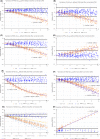Icteric human samples: Icterus index and method of estimating an interference-free value for 16 biochemical analyses
- PMID: 28397988
- PMCID: PMC6816870
- DOI: 10.1002/jcla.22229
Icteric human samples: Icterus index and method of estimating an interference-free value for 16 biochemical analyses
Abstract
Background: Hemolysis, Icterus, and Lipemia constituting the HIL index, are the most common causes of interference with accurate measurement in biochemistry. This study focuses on bilirubin interference, aiming to identify the analyses impacted and proposing a way to predict nominal interference-free analyte concentrations, based on both analyte level and Icterus Index (Iict ).
Methods: Sixteen common analytes were studied: alanine aminotransferase (ALT), albumin (ALB), alkaline phosphatase (ALP), amylase (AMY), aspartate aminotransferase (AST), total cholesterol (CHOLT), creatinine (CREA, enzymatic method), fructosamine (FRUC), gamma-glutamyl transferase (GGT), HDL cholesterol (HDLc), total iron (Iron), lipase (LIP), inorganic phosphorus (Phos), total protein (PROT), triglycerides (TG), and uric acid (UA). Both the traditional 10% change in concentrations from baseline and the Total Change Level (TCL) were taken as acceptance limits. Nineteen pools of sera covering a wide range of values were tested on the Cobas® 6000 (Roche Diagnostics). Iict ranged from 0 to 60.
Results: Eight analytes increased (FRUC and Phos) or decreased (CHOLT, CREA, HDLc, PROT, TG, and UA) significantly when Iict increased. FRUC, HDLc, PROT, and UA showed a linear relationship when Iict increased. A non-linear relationship was found for TG, CREA, and for CHOLT; this also depended on analyte levels. Others were not impacted, even at high Iict .
Conclusions: A method of estimating an interference-free value for FRUC, HDLc, PROT, Phos, UA, TG, and CREA, and for CHOLT in cases of cholestasis, is proposed. Iict levels are identified based on analytical performance goals, and equations to recalculate interference-free values are also proposed.
Keywords: bilirubin; biochemistry; correction; icterus index; interference.
© 2017 Wiley Periodicals, Inc.
Figures


Similar articles
-
Definition of icteric interference index for six biochemical analytes.Biochem Med (Zagreb). 2023 Jun 15;33(2):020702. doi: 10.11613/BM.2023.020702. Biochem Med (Zagreb). 2023. PMID: 37324113 Free PMC article.
-
[Lipemia and bilirubin influences for twenty-four biochemical parameters measurement].Ann Biol Clin (Paris). 2015 Nov-Dec;73(6):671-89. doi: 10.1684/abc.2015.1088. Ann Biol Clin (Paris). 2015. PMID: 26635048 French.
-
A comparative research on obesity hypertension by the comparisons and associations between waist circumference, body mass index with systolic and diastolic blood pressure, and the clinical laboratory data between four special Chinese adult groups.Clin Exp Hypertens. 2018;40(1):16-21. doi: 10.1080/10641963.2017.1281940. Epub 2017 Oct 30. Clin Exp Hypertens. 2018. PMID: 29083240
-
Serum indices: managing assay interference.Ann Clin Biochem. 2016 Sep;53(Pt 5):527-38. doi: 10.1177/0004563216643557. Epub 2016 May 3. Ann Clin Biochem. 2016. PMID: 27147624 Review.
-
The impact of pre-analytical variations on biochemical analytes stability: A systematic review.J Clin Lab Anal. 2020 Dec;34(12):e23551. doi: 10.1002/jcla.23551. Epub 2020 Sep 1. J Clin Lab Anal. 2020. PMID: 32869910 Free PMC article.
Cited by
-
The CONSTANCES Cohort Biobank: An Open Tool for Research in Epidemiology and Prevention of Diseases.Front Public Health. 2020 Dec 10;8:605133. doi: 10.3389/fpubh.2020.605133. eCollection 2020. Front Public Health. 2020. PMID: 33363097 Free PMC article.
-
Frequency of icteric interference in clinical chemistry laboratory tests and causes of severe icterus.Pract Lab Med. 2021 Oct 23;27:e00259. doi: 10.1016/j.plabm.2021.e00259. eCollection 2021 Nov. Pract Lab Med. 2021. PMID: 34761095 Free PMC article.
-
Data on the frequency and causes of icteric interference in clinical chemistry laboratory tests.Data Brief. 2021 Dec 30;40:107771. doi: 10.1016/j.dib.2021.107771. eCollection 2022 Feb. Data Brief. 2021. PMID: 35036480 Free PMC article.
-
Definition of icteric interference index for six biochemical analytes.Biochem Med (Zagreb). 2023 Jun 15;33(2):020702. doi: 10.11613/BM.2023.020702. Biochem Med (Zagreb). 2023. PMID: 37324113 Free PMC article.
References
-
- Monneret D, Mestari F, Atlan G, et al. Hemolysis indexes for biochemical tests and immunoassays on Roche analyzers: determination of allowable interference limits according to different calculation methods. Scand J Clin Lab Invest. 2015;75:162‐169. - PubMed
-
- Agarwal S, Vargas G, Nordstrom C, Tam E, Buffone GJ, Devaraj S. Effect of interference from hemolysis, icterus and lipemia on routine pediatric clinical chemistry assays. Clin Chim Acta. 2015;438:241‐245. - PubMed
-
- Salvagno GL, Lippi G, Gelati M, Guidi GC. Hemolysis, lipaemia and icterus in specimens for arterial blood gas analysis. Clin Biochem. 2012;45:372‐373. - PubMed
-
- Ji JZ, Meng QH. Evaluation of the interference of hemoglobin, bilirubin, and lipids on Roche Cobas 6000 assays. Clin Chim Acta. 2011;412:1550‐1553. - PubMed
MeSH terms
Substances
LinkOut - more resources
Full Text Sources
Other Literature Sources
Miscellaneous

